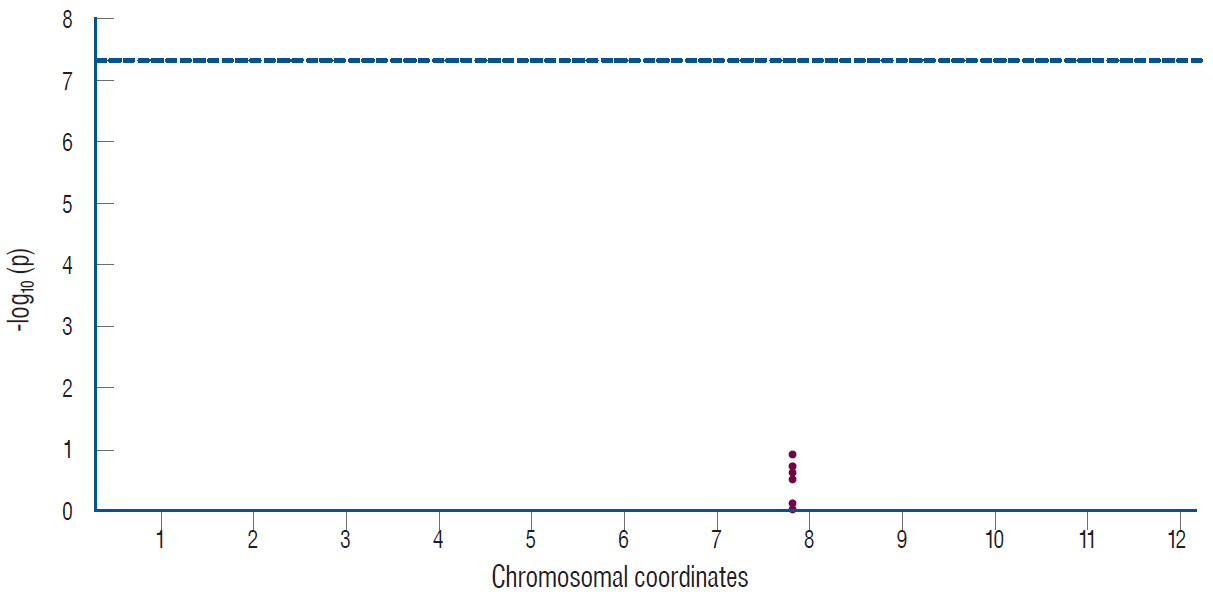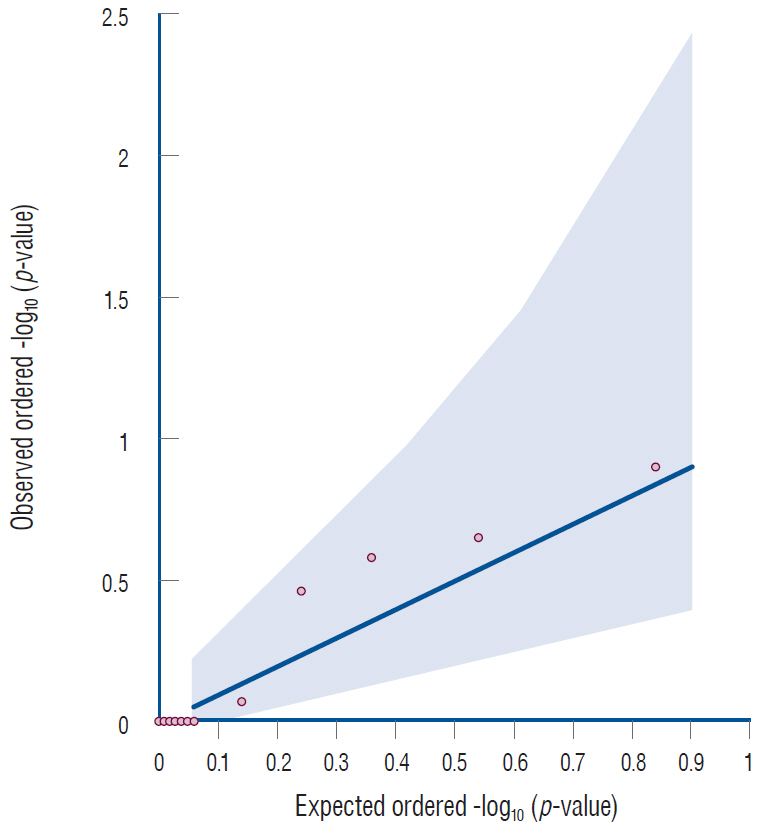J Korean Neurosurg Soc.
2020 Sep;63(5):539-549. 10.3340/jkns.2019.0082.
The Efficacy of P2Y12 Reactive Unit to Predict the Periprocedural Thromboembolic and Hemorrhagic Complications According to Clopidogrel Responsiveness and Safety of Modification of Dual Antiplatelet Therapy : A Meta-Analysis
- Affiliations
-
- 1Department of Public Health, 1 Graduate School of Korea University, Seoul, Korea
- 2Department of Neurosurgery, 2 Soonchunhyang University Cheonan Hospital, Soonchunhyang University College of Medicine, Cheonan, Korea
- 3Department of Neurosurgery, 3 Soonchunhyang University Seoul, Hospital, Soonchunhyang University College of Medicine, Seoul, Korea
- 4Department of Neurosurgery, 4 Soonchunhyang University Bucheon Hospital, Soonchunhyang University College of Medicine, Bucheon, Korea
- KMID: 2506017
- DOI: http://doi.org/10.3340/jkns.2019.0082
Abstract
- The efficacy of P2Y12 reaction unit (PRU) of VerifyNow still remains as a controversial issue in neurointervention. So we investigated the usefulness of PRU of VerifyNow to predict the peri-procedural thromboembolic events (TE) and hemorrhagic events (HE). And we evaluated the safety of modified dual antiplatelet therapy (DAPT) or triple antiplatelet therapy (TAPT) for clopidogrel hyporesponders. We searched MEDLINE, EMBASE, the Cochrane Central Register of Controlled Trials, Web of Science and Scopus on August 19 2018. Data was collected the 1) incidence of TE between clopidogrel responder and clopidogrel hypo-responder, 2) incidence of HE between clopidogrel hyper-responder and clopidogrel responder and hypo-responder, and 3) incidence of TE and HE between modified DAPT or TAPT and standard DAPT in clopidogrel hypo-responder. High cut-off value of PRU was defined as PRU >40% or <220. Fifteen studies were enrolled. Clopidogrel responder showed lower incidence of TE than hypo-responder (risk ratio [RR], 0.32; 95% confidence interval [CI], 0.17-0.61; p<0.001). With the high cut-off value of PRU, clopidogrel responder showed more lower incidence of TE than hypo-responder (RR, 0.11; 95% CI, 0.02-0.45; p=0.002). The incidence of periprocedural HE have higher on clopidogrel hyper-responder than clopidogrel responder and hypo-responder (RR, 4.26; 95% CI, 1.10-16.44; p=0.04; I2=66%). The incidence of periprocedural TE after changing regimen of DAPT for clopidogrel hypo-responder have a tendency to reduce, but there was no significant difference between modified DAPT or TAPT group and standard DAPT group (p>0.05). The incidence of periprocedural HE after changing regimen of DAPT for clopidogrel hypo-responder was no significant difference between modified DAPT or TAPT group and standard DAPT group (p>0.05). PRU is a useful tool as a predictor of peri-procedural TE or HE on neurointervention. PRU has a threshold effect of cut-off value to predict the peri-procedural TE. Modified DAPT or TAPT to prevent TE in clopidogrel hypo-responders could not reduce the incidence of TE. We should investigate the further research about modification of regiment on neurointervention.
Figure
Reference
-
References
1. Alg VS, Sofat R, Houlden H, Werring DJ. Genetic risk factors for intracranial aneurysms: a meta-analysis in more than 116,000 individuals. Neurology. 80:2154–2165. 2013.
Article2. Bilguvar K, Yasuno K, Niemelä M, Ruigrok YM, von Und Zu Fraunberg M, van Duijn CM, et al. Susceptibility loci for intracranial aneurysm in European and Japanese populations. Nat Genet. 40:1472–1477. 2008.
Article3. Caranci F, Briganti F, Cirillo L, Leonardi M, Muto M. Epidemiology and genetics of intracranial aneurysms. Eur J Radiol. 82:1598–1605. 2013.
Article4. Chalouhi N, Ali MS, Jabbour PM, Tjoumakaris SI, Gonzalez LF, Rosenwasser RH, et al. Biology of intracranial aneurysms: role of inflammation. J Cereb Blood Flow Metab. 32:1659–1676. 2012.
Article5. Cho YD, Jeon JP, Rhim JK, Park JJ, Yoo RE, Kang HS, et al. Progressive thrombosis of small saccular aneurysms filled with contrast immediately after coil embolization: analysis of related factors and long-term follow-up. Neuroradiology. 57:615–623. 2015.
Article6. Cho YD, Kim SE, Lim JW, Choi HJ, Cho YJ, Jeon JP. Protected versus unprotected carotid artery stenting : meta-analysis of the current literature. J Korean Neurosurg Soc. 61:458–466. 2018.
Article7. Du Y, Martin JS, McGee J, Yang Y, Liu EY, Sun Y, et al. A SNP panel and online tool for checking genotype concordance through comparing QR codes. PLoS One. 12:e0182438. 2017.
Article8. Fuying Z, Yingying Y, Shining Z, Kezhong Z, Yanyan S, Xuemei Z, et al. Novel susceptibility genes were found in a targeted sequencing of stroke patients with or without depression in the Chinese Han population. J Affect Disord. 255:1–9. 2019.
Article9. Hashikata H, Liu W, Inoue K, Mineharu Y, Yamada S, Nanayakkara S, et al. Confirmation of an association of single-nucleotide polymorphism rs1333040 on 9p21 with familial and sporadic intracranial aneurysms in Japanese patients. Stroke. 41:1138–1144. 2010.
Article10. Hixson JE, Jun G, Shimmin LC, Wang Y, Yu G, Mao C, et al. Whole exome sequencing to identify genetic variants associated with raised atherosclerotic lesions in young persons. Sci Rep. 7:4091. 2017.
Article11. Hong EP, Jeon JP, Kim SE, Yang JS, Choi HJ, Kang SH, et al. A novel association between lysyl oxidase gene polymorphism and intracranial aneurysm in Koreans. Yonsei Med J. 58:1006–1011. 2017.
Article12. Hong EP, Kim BJ, Cho SS, Yang JS, Choi HJ, Kang SH, et al. Genomic variations in susceptibility to intracranial aneurysm in the Korean population. J Clin Med. 8:275. 2019.
Article13. Hong EP, Kim BJ, Kim C, Choi HJ, Jeon JP. Association of sox17 gene polymorphisms and intracranial aneurysm: a case-control study and meta-analysis. World Neurosurg. 110:e823–e829. 2018.
Article14. Hong EP, Park JW. Sample size and statistical power calculation in genetic association studies. Genomics Inform. 10:117–122. 2012.
Article15. Jeon JP, Cho YD, Rhim JK, Yoo DH, Kang HS, Kim JE, et al. Extended monitoring of coiled aneurysms completely occluded at 6-month follow-up: late recanalization rate and related risk factors. Eur Radiol. 26:3319–3326. 2016.
Article16. Jeon JP, Hong EP, Kim JE, Ha EJ, Cho WS, Son YJ, et al. Genetic risk assessment of elastin gene polymorphisms with intracranial aneurysm in Koreans. Neurol Med Chir (Tokyo). 58:17–22. 2018.
Article17. Kim BJ, Kim Y, Hong EP, Jeon JP, Yang JS, Choi HJ, et al. Correlation between altered DNA methylation of intergenic regions of ITPR3 and development of delayed cerebral ischemia in subarachnoid hemorrhage patients. World Neurosurg. 130:e449–e456. 2019.18. Kim CH, Jeon JP, Kim SE, Choi HJ, Cho YJ. Endovascular treatment with intravenous thrombolysis versus endovascular treatment alone for acute anterior circulation stroke : a meta-analysis of observational studies. J Korean Neurosurg Soc. 61:467–473. 2018.
Article19. Kim TG, Kim NK, Baek MJ, Huh R, Chung SS, Choi JU, et al. The relationships between endothelial nitric oxide synthase polymorphisms and the formation of intracranial aneurysms in the Korean population. Neurosurg Focus. 30:E23. 2011.
Article20. Lee S, Kim IK, Ahn JS, Woo DC, Kim ST, Song S, et al. Deficiency of endothelium-specific transcription factor Sox17 induces intracranial aneurysm. Circulation. 131:995–1005. 2015.
Article21. Li B, Hu C, Liu J, Liao X, Xun J, Xiao M, et al. Associations among genetic variants and intracranial aneurysm in a Chinese population. Yonsei Med J. 60:651–658. 2019.
Article22. Nahed BV, Bydon M, Ozturk AK, Bilguvar K, Bayrakli F, Gunel M. Genetics of intracranial aneurysms. Neurosurgery. 60:213–225. discussion 225-226. 2007.
Article23. Petersen BS, Fredrich B, Hoeppner MP, Ellinghaus D, Franke A. Opportunities and challenges of whole-genome and -exome sequencing. BMC Genet. 18:14. 2017.
Article24. Song MK, Kim MK, Kim TS, Joo SP, Park MS, Kim BC, et al. Endothelial nitric oxide gene T-786C polymorphism and subarachnoid hemorrhage in Korean population. J Korean Med Sci. 21:922–926. 2006.
Article25. Teer JK, Mullikin JC. Exome sequencing: the sweet spot before whole genomes. Hum Mol Genet. 19(R2):R145–R151. 2010.
Article26. Wu Y, Li Z, Shi Y, Chen L, Tan H, Wang Z, et al. Exome sequencing identifies LOXL2 mutation as a cause of familial intracranial aneurysm. World Neurosurg. 109:e812–e818. 2018.
Article27. Yamada Y, Kato K, Oguri M, Horibe H, Fujimaki T, Yasukochi Y, et al. Identification of nine genes as novel susceptibility loci for early-onset ischemic stroke, intracerebral hemorrhage, or subarachnoid hemorrhage. Biomed Rep. 9:8–20. 2018.
Article28. Yasuno K, Bilguvar K, Bijlenga P, Low SK, Krischek B, Auburger G, et al. Genome-wide association study of intracranial aneurysm identifies three new risk loci. Nat Genet. 42:420–425. 2010.
Article
- Full Text Links
- Actions
-
Cited
- CITED
-
- Close
- Share
- Similar articles
-
- Effect of Premedication Method and Drug Resistance of Antiplatelet Agent on Periprocedural Thromboembolic Events During Coil Embolization of an Unruptured Intracranial Aneurysm
- A Comparative Study the USA, Europe and Korea Guidelines of Antiplatelet Therapy for Patients with Acute Coronary Syndrome
- De-escalation strategies of dual antiplatelet therapy in patients undergoing percutaneous coronary intervention for acute coronary syndrome
- Clopidogrel Response Variability in Unruptured Intracranial Aneurysm Patients Treated with Stent-Assisted Endovascular Coil Embolization : Is Follow-Up Clopidogrel Response Test Necessary?
- New Oral Antiplatelet Agents




